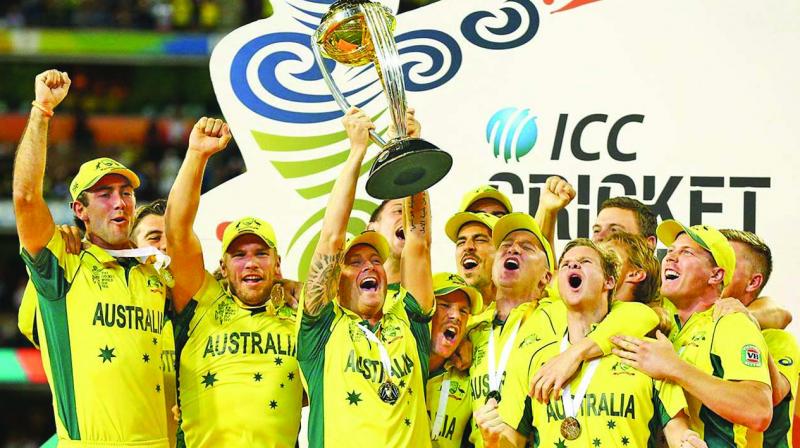Introduction
The 2015 ICC Cricket World Cup, hosted jointly by Australia and New Zealand, was a cricketing extravaganza that captivated audiences worldwide. With a revamped format, electrifying matches, and stellar performances, the tournament unfolded as a celebration of the sport’s spirit and talent. In this narrative, we delve into the gripping journey of the 2015 World Cup, highlighting key moments, standout players, and the remarkable triumph of the champions.
A New Format: All Eyes on the Pool Stages
The 2015 World Cup introduced a fresh format. Fourteen teams were divided into two pools, Pool A and Pool B, where each team played against the others in their group. This round-robin format ensured intense competition and allowed every team to showcase their skills. The top four teams from each pool advanced to the knockout stages, setting the stage for thrilling encounters.
Pool A: New Zealand’s Dominance and Australia’s Might
In Pool A, New Zealand emerged as the standout team. Their aggressive style of play, led by Captain Brendon McCullum, captured attention. The Kiwis won all their matches, displaying a blend of power-hitting and disciplined bowling. Meanwhile, Australia, with their formidable batting lineup and fierce fast bowlers, showcased their dominance. They comfortably advanced to the knockout stages, bolstered by stellar performances from players like David Warner, Steve Smith, and Mitchell Starc.
Pool B: India’s Resurgence and South Africa’s Brilliance
In Pool B, defending champions India showed their mettle. Led by the ever-composed M.S. Dhoni, India displayed remarkable consistency. Their batting, anchored by Virat Kohli, and bowling, led by Mohammed Shami and Ravichandran Ashwin, proved formidable. South Africa, with their star-studded lineup including AB de Villiers and Dale Steyn, demonstrated their prowess. Despite a few hiccups, they powered through to the knockout stages, leaving fans eagerly anticipating their performance in the crucial matches ahead.
Knockout Stages: Drama Unfolds in the Quarters and Semis
The knockout stages witnessed high-stakes encounters that kept fans on the edge of their seats. In the quarter-finals, South Africa clashed with Sri Lanka, while India faced Bangladesh. South Africa, known for their history of World Cup heartbreaks, overcame the challenge from Sri Lanka, with de Villiers leading the way with a century. India, on the other hand, put up a clinical performance against Bangladesh, reaching the semi-finals with a commanding win.
In the other quarter-finals, New Zealand faced West Indies, and Australia took on Pakistan. New Zealand continued their impressive form, defeating West Indies, while Australia, powered by a spectacular century from Smith, triumphed over Pakistan. These victories set the stage for intense semi-final clashes that would determine the finalists.
Semi-Finals: Australia vs. India and New Zealand vs. South Africa
In the first semi-final, Australia faced India at the Sydney Cricket Ground. Australia’s bowlers, led by Mitchell Johnson and Starc, restricted India’s batting powerhouse to a modest total. In response, Smith’s brilliant century and a quickfire fifty by Aaron Finch guided Australia to a convincing victory, securing their spot in the final.
The second semi-final, held at Eden Park, Auckland, was a nail-biting contest between New Zealand and South Africa. New Zealand, batting first, posted a challenging total, thanks to an explosive innings by Grant Elliott. South Africa, in pursuit of the target, displayed a valiant effort, with de Villiers leading the charge. However, in a dramatic last over, with South Africa needing seven runs to win, Elliott emerged as the hero, guiding New Zealand to a thrilling victory and their first-ever World Cup final.
The Final: Australia vs. New Zealand – A Trans-Tasman Battle
The final, played at the Melbourne Cricket Ground on March 29, 2015, was a grand spectacle that brought the cricketing world to a standstill. Australia, the co-hosts and favorites, faced off against the determined New Zealand team. In front of a packed stadium, Australia won the toss and chose to bat.
Australia’s innings was marked by a scintillating century from Michael Clarke, the Australian captain. His composed innings and vital partnerships with Steve Smith and Shane Watson propelled Australia to a formidable total of 7/ 245 in their 50 overs.
In reply, New Zealand faced a daunting target. Brendon McCullum, New Zealand’s dynamic captain, fell early, setting the tone for a challenging chase. Kane Williamson’s gritty fifty provided some resistance, but the relentless pressure from Australia’s bowlers, especially Starc, proved too much. In a fitting climax, Starc bowled the final delivery, clean-bowling Grant Elliott and securing Australia’s victory by 7 wickets. Australia lifted the coveted trophy for the fifth time, showcasing their dominance in world cricket.
Impact and Legacy
The 2015 Cricket World Cup left a lasting impact on the sport. It showcased the intensity and excitement of one-day cricket, capturing the hearts of millions of fans. Australia’s triumph, characterized by their clinical performances and team synergy, became a source of inspiration for aspiring cricketers worldwide.
Moreover, the tournament highlighted the emergence of new talents and the resurgence of established players. Players like Mitchell Starc, Steve Smith, and Trent Boult became household names, marking the beginning of their illustrious careers. The event also emphasized the significance of teamwork, strategy, and mental fortitude in high-pressure situations.
In conclusion, the 2015 ICC Cricket World Cup was a spectacle of talent, determination, and sportsmanship. The tournament’s memorable matches, stellar performances, and unforgettable moments became an integral part of cricketing folklore. As the world celebrated Australia’s victory and the brilliance of players from various nations, the tournament reinforced the universal appeal of cricket, transcending borders and cultures.




